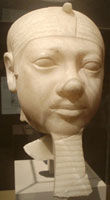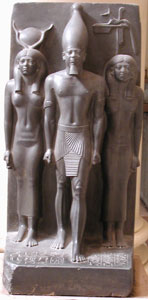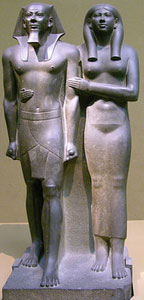

Menkaure (Menkaura, “Eternal like the souls of Re”) ruled during the fourth dynasty (Old Kingdom) of Ancient Egypt. He may also have used the names Kakhet and Hornub. It is thought that he was either the son of Khufu or the son of Khafre. The Turin Kings list places another pharaoh between Menkaure and Khafre, but the name is damaged.
There is also a rock inscription at Wadi Hamamat dating to the Middle Kingdom which lists Khufu, Djedefre, Khafre, Hordjedef (Djedefhor), and Bauefre (Baufra), but does not mention Menkaure. Unfortunately, it is not clear that this is a list of kings, as some have suggested that Hordjedef was the son of Khufu and a crown prince, but never pharaoh, while Bauefre was another son of Khufu who may have acted as vizier.

According to the Turin Kings list Menkaure ruled for eighteen years. Manetho credits him with a massive sixty-three year reign, while some experts have suggested that he may have actually ruled for around twenty-eight years. His eldest son, Prince Khuenre, died before him and he was succeeded by another of his sons, Shepseskhaf who completed his pyramid and mortuary temple at Giza.

According to Herodotus, Menkaure was a benevolent ruler, unlike either Khufu or Khafre. Herodotus reports that he “reopened the temples and allowed the people, who were ground down to the lowest point of misery, to return to their occupations and to resume the practice of sacrifice”. However, the Gods had apparently decreed that Egypt should suffer tyranny for one hundred and fifty years and did not approve of his gentle ways. The oracle at Buto warned him that he would only reign for six more years, so he filled each day with drinking and merriment, never pausing to sleep, and so extended his life by twelve years instead of six. Herodotus also claims that his daughter committed suicide. The distraught king ordered that her corpse be buried in a wooden bull.
Evidence from his reign would support the suggestion that he was a beneficent ruler. The tombs of his officials boast large numbers of statues and frequent references to his generosity. For example, an inscription in the tomb of Debhen states that the pharaoh actually granted him limestone from the royal quarry at Tura to build his monument. Menkaure also decreed that the children of officials were educated along with the royal children. There is even some evidence, in the form of scarabs, that he was venerated as late as the twenty-sixth dynasty.


He built his pyramid at Giza which he named “Menkaure is divine”. His pyramid complex included a satellite pyramid for his wife Khamerernebty II. Archaeologists have recovered a number of beautiful statues of Menkaure including fine examples which depict the king with Khamerernebty II and others in which he appears with Hathor and a series of nome gods. A number of unfinished statues were also recovered, supporting the suggestion that the king died suddenly.
Pharaoh’s Names
Manetho; Mencheres
Horus name (above): Ka Khet “Horus With The Body Of A Bull”

Nebty: Ka (the bull of the two ladies)

Golden Horus: bik nebu netjer (The golden falcon is divine)

Nomen: Menkaure, Eternal like the souls of Ra (Abydos Kings List)

Nomen: Menkaure, Eternal like the souls of Ra

Nomen: Menkare, Eternal like the soul of Ra
Bibliography
- Kathryn Bard (2008) An introduction to the Archaeology of Ancient Egypt
- Peter A Clayton (1994) Chronicle of the Pharaohs
- E Hornung (1999) History of Ancient Egypt
- M Van de Mieroop (2010) A History of Ancient Egypt
Copyright J Hill 2015